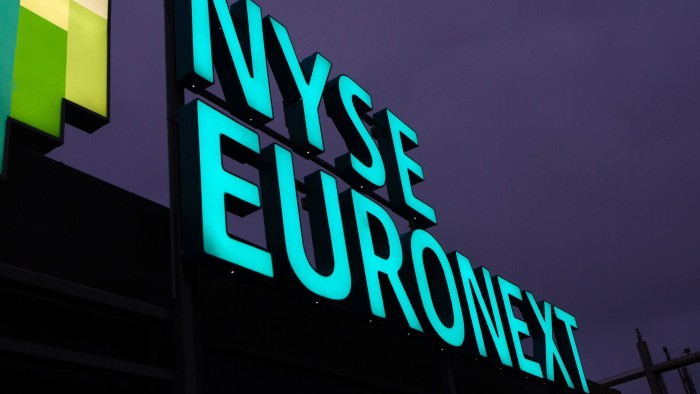Long-term questions as Euronext’s momentum gathers pace

Simply sign up to the Commodities myFT Digest -- delivered directly to your inbox.
Six months after regaining its independence, momentum is developing around Euronext.
Shares in the group — Europe’s fourth-largest exchange by market capitalisation — are now trading at around €25 apiece, having languished for several months below June’s €20 listing price. The market is beginning to acknowledge its extensive cost cutting and speculate on possible dividend payouts on next year’s earnings. What, though, is the longer-term play for Euronext?
This year has been about the return of the initial public offering. Revenues from equity capital markets now account for 50 per cent of total turnover. But exchanges have only limited control over listing and trading decisions.
What it can control are derivatives and market data. Derivatives trading accounts for 10 per cent of revenues, and sales of market data and licensing its benchmark indices a further 21 per cent, according to a recent research note from Royal Bank of Canada. To boost those numbers, Euronext has been developing a series of financial and commodity futures.
It is using its strong brand in Europe and links to commodity producers with a series of niches futures contacts for milling wheat, dairy futures and rapeseed.
In financial futures, it has licensed its Amsterdam AEX and Paris CAC 40 indices to Goldman Sachs to create its own structured products. There will also be some single stock dividend futures, plus a new over-the-counter trade reporting service which looks akin to NYSE Euronext’s old bClear service, and an idea whose time may yet come as new regulation kicks in.
Perhaps the most interesting product is the January launch of weekly futures on the CAC index, one of the most actively-traded index futures contracts in Europe. (More popular than the FTSE 100 futures index, for example).
Futures contracts typically have a much longer expiration date but Euronext believes that the tough capital charges mean banks need a tool that offers more precise hedging and will tie up capital for a shorter period of time.
Inevitably some innovations will fail but what happens if a few succeed handsomely? It could bring the issue of Euronext’s clearing arrangements back into question.
At present it uses the London Stock Exchange Group-controlled LCH.Clearnet to clear both its cash and derivatives trades. Although it does not have its own clearing house, clearing is 7 per cent of Euronext’s revenue, owing to a revenue sharing agreement in place on derivatives until 2018.
RBC has estimated Euronext would earn €34.4m this year from the nine months the new arrangements were in place. That rises to €47.9m next year and excludes gains from new products.
With a handful of in-demand contracts, would Euronext be as comfortable with its clearing arrangements in the hands of a rival, however well intentioned?
For now Euronext says it is very happy with its current arrangements. And with Mifid II market rules coming into effect from January 2017, it is no surprise there’s little appetite to jump into such murky waters right now.
But it would not be a surprise to see Euronext seek fuller control of its derivatives clearing operations. Rather than building its own, as it tried to in 2013, a simpler solution may be to buy one. As the recent round of clearing house authorisations has showed, there are several to choose from in Europe. Expansion via central Europe, or even Spain’s Bolsas y Mercados Españoles?
One to watch for 2015.
Comments